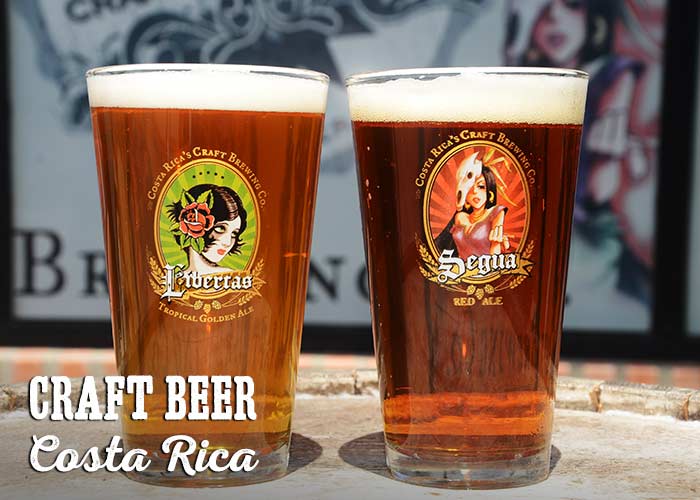What’s the only thing better than visiting Costa Rica?
Visiting Costa Rica with a cold beer or rum drink in your hand!
It gets hot in the tropics. What better way to cool off than with a tasty adult beverage on a beautiful Costa Rican beach? Listed below are my favorite drinks to pair with tasty Costa Rican food.

Costa Rican Liquor
Guaro
Say hello to Costa Rica’s cheapest and most popular spirit.
Every Latin American country has it’s own sugar cane liquor. They are similar to vodka but sweeter and with a lower alcohol content (about 30%).
In Costa Rica that cane liquor is called guaro. Produced by the government, it goes under the brand name Cacique.
Guaro is generally drank straight or mixed into the following drinks:
Guaro Sour
Similar to a Whiskey Sour, the classic Guaro Sour consists of guaro, lime, sugar and club soda.
Chiliguaro
Over the past few years chiliguaro has taken Costa Rica by storm. The main ingredients are guaro and hot sauce. Other ingredients are debatable.
Rum
Rum (“ron” in Spanish) is your best bet for hard liquor in Costa Rica. Costa Rica’s most popular rum, Ron Centenario, is high quality and a terrific value.
But in my opinion, the rums produced by Costa Rica’s neighbors are better. Nicaragua’s Fleur de Caña is terrific and widely available. Panama’s Ron Abuelo is another great choice. And if you really want to go high end, pick up a bottle of Ron Zacapa from Guatemala.

Vino de Coyol
I’ll never forget when my Spanish teacher Pablo told me of a strange indigenous beverage fermented from the sap of a poisonous tree. It would make you fantastically drunk, he told me, and if you got too much sunlight the next day, it would make you drunk again.
Naturally, I had to try it.
Along a certain stretch of road in northwest Costa Rica (revealed in my book Costa Rica: The Complete Guide), street vendors sell handcrafted vino de coyol. If you think tequila makes you loopy, wait till you try this mysterious white liquid.
According to the traditions of Costa Rica’s indigenous Chorotega people, coyol trees are chopped down three days after the full moon at low tide. A sweet, watery sap is then extracted from the trunk and fermented.
Contrabando
In many rural areas, home distillers make illegal “moonshine” with the terrific name contrabando.
A friend of mine lives in a small village where a fellow named Gilberto makes delicious moonshine at home. One day my friend spotted two police cars parked in front of Gilberto’s house. When my friend saw Gilberto later that day, he asked if everything was ok.
“Of course,” Gilberto replied. “The police just wanted to buy some of my contrabando!”
Costa Rican Beer
Industrial Beer
Two major brands dominate Costa Rica’s beer market: Pilsen and Imperial. These two pale lagers were first brewed in 1888 and 1924 respectively.
Pilsen, distinguished by its red and white label, has an ABV of 5.1%.
Imperial, famous for its black aguila (“eagle”) logo, has an ABV of 4.6%.
Although many Costa Ricans express a strong preference for one or the other, they are about as different as Budweiser and Coors.
That said, I find both Pilsen and Imperial superior to mass-market beers in the U.S.
A third option is Bavaria Dark, introduced in 2001. This Dunkle-style beer features more malt than hops and an ABV of 5%.

Craft Beer
In recent years, dozens of local craft brewers have chipped away at Pilsen and Imperial’s virtual beer monopoly.
The company that ushered in Costa Rica’s craft beer revolution was Costa Rica Craft Brewing. In 2010 they unveiled two flagship brews: Libertas, a tropical golden ale, and Segua, a red ale named after Costa Rica’s most famous legend.
Today there are nearly 100 craft beers in Costa Rica. In my opinion, Costa Rica Craft Brewing is still the best, but Treintaycinco is another great option.